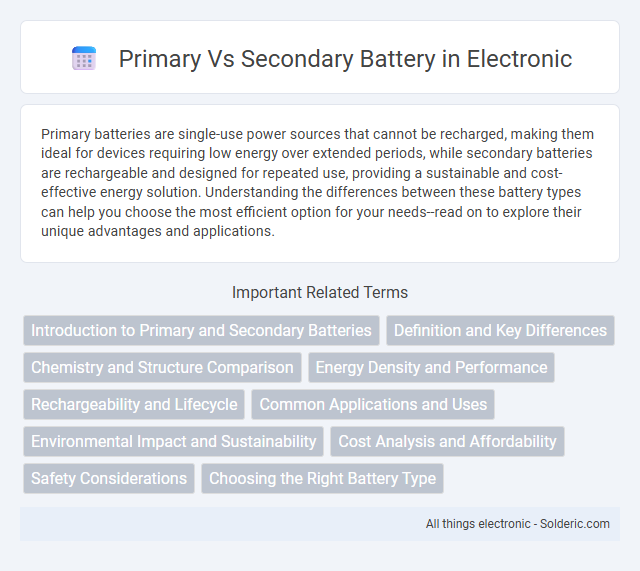Primary batteries are single-use power sources that cannot be recharged, making them ideal for devices requiring low energy over extended periods, while secondary batteries are rechargeable and designed for repeated use, providing a sustainable and cost-effective energy solution. Understanding the differences between these battery types can help you choose the most efficient option for your needs--read on to explore their unique advantages and applications.
Comparison Table
| Feature | Primary Battery | Secondary Battery |
|---|---|---|
| Definition | Non-rechargeable battery designed for single use | Rechargeable battery that can be used multiple times |
| Rechargeability | No, disposable after discharge | Yes, can be recharged and reused |
| Common Examples | Alkaline, Zinc-Carbon, Lithium primary | Lead-Acid, Nickel-Cadmium (NiCd), Lithium-Ion (Li-ion) |
| Cost | Lower initial cost | Higher initial investment |
| Energy Density | Generally higher energy density for one-time use | Lower energy density but better lifecycle energy output |
| Lifespan | Single discharge cycle | Multiple charge-discharge cycles (hundreds to thousands) |
| Environmental Impact | More waste disposal issues | Less waste, better sustainability |
| Typical Applications | Remote controls, clocks, flashlights | Mobile phones, laptops, electric vehicles |
Introduction to Primary and Secondary Batteries
Primary batteries are single-use electrochemical cells designed for disposability after their energy is depleted, commonly found in devices like remote controls and flashlights. Secondary batteries, such as lithium-ion and nickel-metal hydride (NiMH), are rechargeable cells enabling multiple cycles of charging and discharging, widely used in smartphones, electric vehicles, and portable electronics. The fundamental difference lies in primary batteries' fixed chemical reactions versus secondary batteries' reversible electrochemical processes, influencing their cost-effectiveness and environmental impact.
Definition and Key Differences
Primary batteries are single-use power sources that cannot be recharged, relying on irreversible chemical reactions to generate electricity, whereas secondary batteries are rechargeable and designed for multiple cycles through reversible electrochemical processes. The key differences include lifespan, cost-effectiveness, and environmental impact; primary batteries offer convenience for low-drain devices, while secondary batteries provide long-term value and sustainability for frequently used electronics. Understanding these distinctions helps you choose the appropriate battery type based on your device's energy demands and usage patterns.
Chemistry and Structure Comparison
Primary batteries use non-rechargeable chemical reactions, typically involving zinc-carbon or alkaline chemistries, with a simpler internal structure designed for one-time use. Secondary batteries employ reversible chemical reactions, such as lithium-ion or nickel-metal hydride, featuring more complex electrode materials and separators to support multiple charge-discharge cycles. Understanding the distinct chemistry and structural differences helps you select the appropriate battery type for your energy needs.
Energy Density and Performance
Primary batteries offer high energy density, making them ideal for low-drain devices where long shelf life is crucial, as they cannot be recharged. Secondary batteries provide better performance in terms of rechargeability and cycle life, supporting repetitive use with moderate energy density suitable for high-drain applications. Understanding the balance between energy density and performance in primary versus secondary batteries helps you select the right power source for your device's specific needs.
Rechargeability and Lifecycle
Primary batteries are non-rechargeable and designed for single-use, providing a limited lifecycle until their energy is fully depleted. Secondary batteries offer rechargeability, allowing multiple charge-discharge cycles that extend their overall lifecycle and reduce waste. Their lifecycle depends on factors such as depth of discharge, charge rate, and battery chemistry, making secondary batteries more cost-effective and environmentally sustainable for long-term applications.
Common Applications and Uses
Primary batteries are commonly used in devices requiring low-drain or infrequent power, such as remote controls, smoke detectors, and flashlights, due to their long shelf life and disposable nature. Secondary batteries are preferred for high-drain, rechargeable applications like smartphones, laptops, and electric vehicles, offering repeated use and cost efficiency over time. Your choice between primary and secondary batteries depends on the balance between convenience, durability, and energy needs specific to your device.
Environmental Impact and Sustainability
Primary batteries, which are single-use and non-rechargeable, generate significant environmental waste due to frequent disposal and contain hazardous materials that can leach into soil and water. Secondary batteries, or rechargeable batteries, offer improved sustainability by reducing waste volume through repeated use and typically employ more advanced, eco-friendlier chemistries that are easier to recycle. Prioritizing secondary battery adoption supports resource conservation and mitigates environmental pollution associated with battery production and disposal.
Cost Analysis and Affordability
Primary batteries typically have a lower upfront cost compared to secondary batteries, making them more affordable for single-use applications. Secondary batteries, though more expensive initially, offer cost savings over time due to their rechargeable nature and longer lifespan. Your choice depends on whether you prioritize immediate affordability or long-term value.
Safety Considerations
Primary batteries are designed for single-use and often have simpler safety mechanisms, making them less prone to leakage or explosion under normal conditions, whereas secondary batteries require careful management due to their rechargeable nature, which can lead to overheating, short circuits, or thermal runaway if improperly handled. Your safety depends on proper charging techniques, avoiding physical damage, and using certified chargers for secondary cells to prevent hazards. Understanding these distinctions is crucial for selecting the right battery type while minimizing risks associated with battery use.
Choosing the Right Battery Type
Choosing the right battery type depends on your device's power demands and usage frequency. Primary batteries are ideal for low-drain or infrequently used devices due to their long shelf life and non-rechargeable nature. Secondary batteries offer rechargeable convenience for high-drain, regularly used electronics, providing cost savings and environmental benefits over time.
Primary vs Secondary battery Infographic

 solderic.com
solderic.com